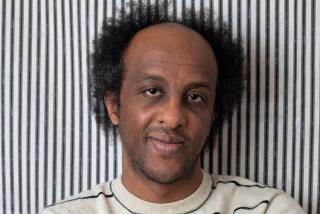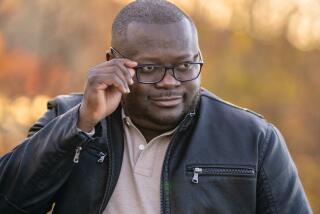Scenes of heaven and earth
The image is iconographic: St. George sits astride his horse, slaying the dragon. Yet, somewhat surprisingly to some viewers, it is painted in bright fuchsia pinks and baby blue pastels. Though they are contrasting colors one might expect from turn-of-the-last-century European painters in experimental salons, the work is born of a 1,500-year-old Ethiopian tradition and was made within the last 25 years.
It’s just one of 35 pieces in “Painting Ethiopia: The Life and Work of Qes Adamu Tesfaw” at the UCLA Fowler Museum of Cultural History. The show attempts to provide a glimpse of Adamu, a man for whom Ethiopia is not just a canvas of many colors and stories, but also a nation that provides a deep sense of spiritual renewal.
In fact, the 74-year-old Adamu was once a priest (“Qes” is an honorific name used for priests in the Ethiopian Orthodox Church). He is now considered Ethiopia’s most successful painter -- one who has challenged the iconography of traditional Orthodox New and Old Testament painting, and who has become a prolific chronicler of urban and historical scenes of Ethiopian life.
Putting his art in a Western context, however, can be difficult. “Adamu’s work is not canonically traditional, with regard to our notion of traditional art, yet it’s not modern in our sense of modern, either,” says show curator Ray Silverman, a professor of the history of art and African American and African studies at the University of Michigan. “It exists in the intersection.”
The history of how Adamu arrived at that intersection is a bit more easily defined.
As a child of the 1930s growing up in Bichena, about 125 miles north of the Ethiopian capital Addis Ababa, Adamu had been so awed by the paintings in the church there that he believed they were created by angels: He called them “heaven paintings.”
After he realized they were man-made, he was empowered to draw some himself, sketching ferociously with charcoal on any material he could find -- fragments of ceramics, or broken bones that he’d soften with an ax or flat stone (he had no access to pen or pencil).
His father encouraged him to express his creative, spiritual bent alongside a mentor, Qes Gebez Anteneh Gebru, a painter and priest closely affiliated with the church. Anteneh taught him to adhere to a prescribed set of ancient rules about iconographic representation; it was in this vein that Adamu learned to paint, as he completed his studies for the priesthood, into which he was ordained at 26.
But four years later, in 1960, Adamu found himself at a crossroads -- he discovered his wife had been cheating on him, and as the Ethiopian Orthodox Church does not allow for priests to divorce, he chose to leave the priesthood, move to Addis Ababa and continue to paint.
Over 40 years, Adamu has produced thousands of paintings, Silverman says.
Adamu’s religious works provide a spin on New and Old Testament tales in depictions of Christ, Mary, St. George, and Solomon and Sheba: The scale, color, dynamism and perspective (Adamu sometimes depicts figures from behind) are considered distinct from other contemporary Ethiopian art.
Adamu’s secular work includes scenes of everyday life, such as “The City of Addis Ababa,” with its bird’s-eye view of statues, churches and tree-lined streets; “Southern People’s Stick Game,” in which young men engage in a bout of stick fighting to win the hand of waiting women in marriage; and “Zar (Adbar Coffee Ceremony),” a scene of a medium summoning a spirit by imbibing the dark brew.
Asked if his depictions of the mundane are also spiritual, Adamu responds broadly through an interpreter: “God is in all places, when you sleep, wake up, shower, eat, walk -- if you believe in God, God is with you.”
In addition, Adamu insists he is “just a teacher,” one who paints stories and moments the way he sees and feels them. He steadfastly refuses to be labeled a social commentator, despite such nightmarish works as “Drought and Famine” and “We Must Unite in Prayer to Fight HIV/AIDS.”
Adamu fiercely denies any political bent in his work, and says in the show’s catalog, “How can I speak about what is going on in somebody’s mind? I just try to do my best. The rest is left up to the observer.” It’s a perspective that Silverman suggests is far from the self-conscious poses heard in the West about being an artist and much more spiritually inclined.
No matter the motivation, it is clear that Adamu’s dedication to Ethiopia is boundless. Of his homeland, he says in a videotape shown at the exhibit: “It’s a green land, a land that always stretches its hand towards its creator.” And so does he.
*
‘Painting Ethiopia’
The Life and Work of Qes Adamu Tesfaw
Where: UCLA Fowler Museum of Cultural History, Sunset and Westwood boulevards, Westwood
When: Noon to 5 p.m. Wednesdays, Fridays through Sundays; noon to 8 p.m. Thursdays
Ends: Sept. 18
Price: Free
Info: (310) 825-4361; www.fowler.ucla.edu
More to Read
The biggest entertainment stories
Get our big stories about Hollywood, film, television, music, arts, culture and more right in your inbox as soon as they publish.
You may occasionally receive promotional content from the Los Angeles Times.










